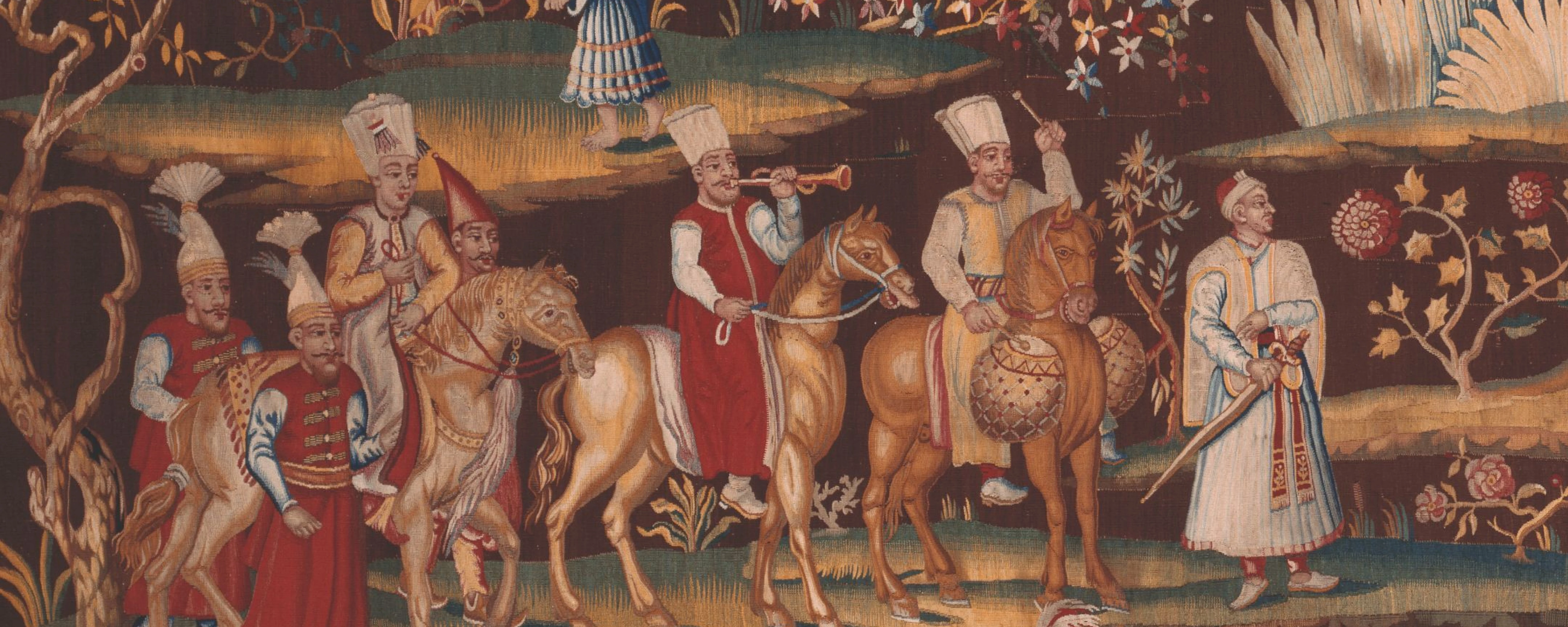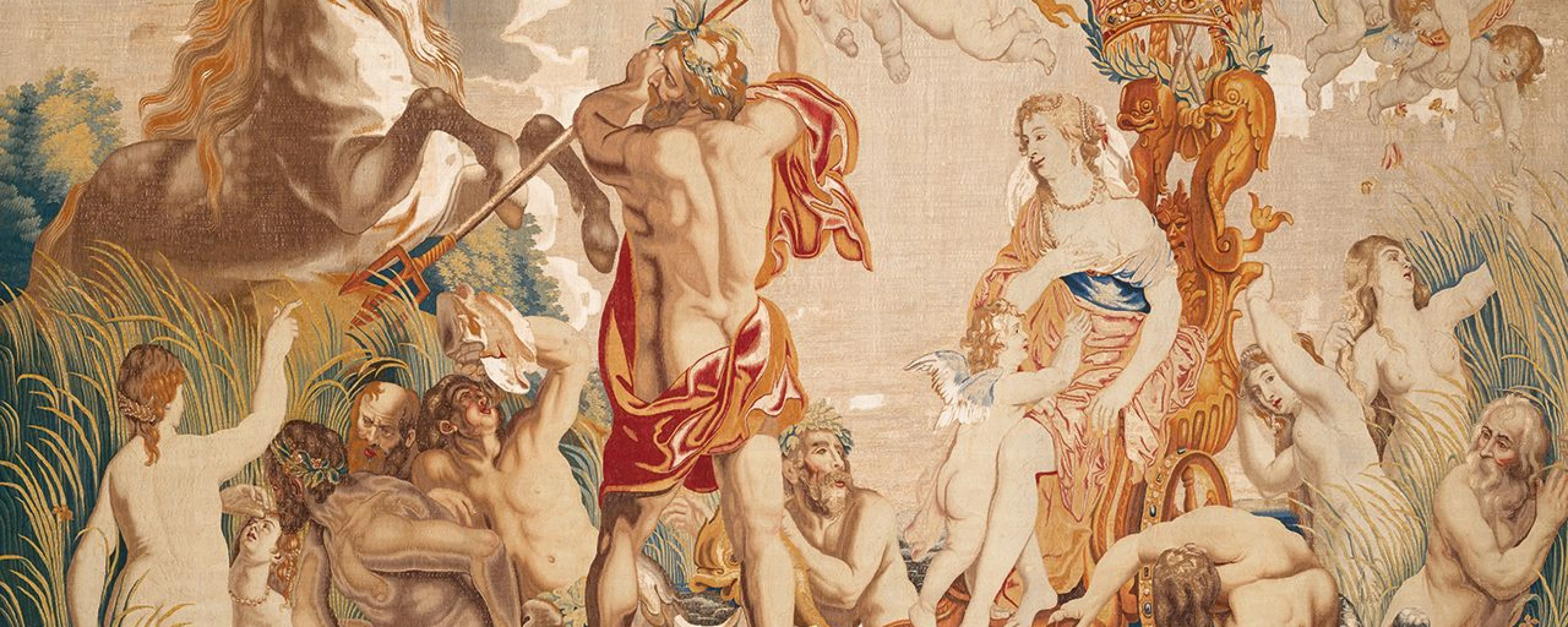The Toms Collection is one of the most significant privately assembled collections of ancient tapestries formed during the second half of the 20th century.
The ancient tapestry collection preserved by Fondation Toms Pauli brings together nearly two hundred tapestries and textiles, offering a panorama of the production of Europe’s leading weaving workshops and manufactories from the sixteenth to the nineteenth centuries. Internationally, the collection is distinguished by the variety, rarity, aesthetic quality, and state of conservation of many of its pieces, placing Fondation Toms Pauli and the State of Vaud alongside other leading heritage institutions such as the Victoria and Albert Museum (London), the Metropolitan Museum of Art (New York), the Hermitage (St Petersburg), the Mobilier National (Paris), and the Patrimonio Nacional (Madrid).
The Mary Toms Bequest
In 1993, the State of Vaud received a major bequest from Mary Toms (1901–1993). By testament, she donated to the cantonal authorities her estate at Coinsins, including the vineyards, chateau, furnishings, and collections, under the condition that the substantial ensemble of tapestries assembled with her husband, Reginald Toms (1892–1978), be conserved and promoted. Largely unknown until then, the collection comprised more than one hundred tapestries, together with embroideries and decorative pieces. Its artistic significance lies in its breadth and representativeness, encompassing works from the principal European weaving centres—Flemish, French, English, and Italian workshops—between the early 16th and late 19th centuries. Thanks to the testatrix’s generous provisions, the proceeds from the sale of Mary Toms’s movable and immovable property funded an extensive restoration campaign, undertaken between 1994 and 2002 at the Manufacture Royale De Wit in Mechelen (Belgium), restoring the tapestries to their former splendour.
In 1958, after making his fortune in real estate, the English developer Reginald Toms and his wife Mary settled at the Château de Coinsins, between Geneva and Lausanne. In the years 1959 to 1969, they remodelled the estate and assembled a major tapestry collection, acquiring most of the works on the London art market. Medium-sized tapestries and decorative pieces adorned the chateau’s interiors, while the larger hangings were displayed in two barns specially converted for the purpose.
Works from the Old Collection
More than fifty tapestries in the Toms Collection attest to the flourishing production of Flemish workshops—particularly in the 17th century, the most prolific period—alongside fine examples from the 16th and 18th centuries. In addition to better-known French productions, the collection also includes rarer examples from English and Italian workshops. A number of European carpets, door hangings, and furnishings further illustrate the eclecticism of Mary and Reginald Toms’ taste in textile art. Fondation Toms Pauli also preserves an extraordinary ensemble of embroideries assembled by the couple, most of which are of English origin.
Selection of works
Workshops of the Old Collection
England
London
– Workshop of Francis Poyntz
– Workshop of George Bradshaw
– Workshop of Leonard Chabaneix
– Workshop of Mortlake
– Workshop of John Vanderbank
Windsor
– Royal Windsor Tapestry Manufactory
Flanders
Oudenaarde
– Workshop of Pontzeel
Bruges
– Workshop of Carlos Janssens
Brussels
– Workshop of Cornelis Mattens
– Workshop of Cornelis Tons
– Workshop of Gerard Peemans
– Workshop of Gérard van der Strecken
– Workshop of Henri I Reydams
– Workshop of Henri II Reydams
– Workshop of Jacques Geubels or his widow Catherine van den Eynde
– Workshop with mark similar to Jan Stomman
– Workshop of Jan van Leefdael
– Workshop of Jean-Baptiste Vermillon (attributed to)
– Workshop of Jean Dermoyen
– Workshop of Jean-François van der Borght
– Workshop of Jean Raes I
– Workshop of Judocus de Vos
– Workshop of Leyniers and Reydams
– Workshop associated with Martin Reymbouts
– Workshop of Paul van Nieuwenhove
– Workshop of Pierre van den Hecke
– Workshop of Urbain Leyniers
France
Aubusson
- Workshop of Votra/Keamcpir
Beauvais
- Workshop of Philippe Béhagle
Lille
- Workshop of Guillaume Werniers
Paris
- Workshop of Hippolyte de Comans in the Faubourg Saint-Marcel
- Manufacture des Gobelins, Workshop of Cozette or Neilson
Italy
Rome
- Barberini Manufacture (Maria Maddalena della Riviera; Italianisation of Van den Vliete)
Works of the Foundation
Access the CatalogueFondation Toms Pauli continues to enrich its holdings with acquisitions of ancient tapestries that complement series already represented in the inventory.
In 2008, the Foundation received The Picnic, formerly adorning the Toms’s apartment in Monaco. This tapestry completes other works from the Children’s Bacchanals series (London, c. 1700).
In 2010, the Foundation acquired an overdoor tapestry depicting Apollo the Sun God, woven between 1660 and 1662 in the Brussels workshop of Gerard van der Strecken. This addition enhanced a major ensemble within the Toms Collection: the Deeds of Scipio the African series of which the Foundation already held three monumental narrative tapestries: Continence of Scipio, Capture of the Camp and the Mercy of the Vanquished, and Conference between Scipio and Hannibal.
In 2023, the foundation acquired a 17th-century Brussels tapestry depicting the Triumph of Titus and Vespasian. Woven in the workshop of Guillaume Van Leefdael after a design by Charles Poerson between 1668 and 1688, this piece belongs to a series of eight scenes recounting the story of the emperors Vespasian and Titus. It complements four other episodes from the cycle already held by the Foundation: Joseph Led before Vespasian and Titus, Assault of a City, Two Women Implore Titus and Vespasian, and Vespasian and Titus Applauded. Together with the Hermitage’s example in St Petersburg, this holding constitutes one of the most complete surviving episodes of the Triumph series.
Le Déjeuner en plein air
Grâce à la générosité de particuliers, la Fondation a reçu en don en 2008 la dernière tapisserie de la collection Toms, Le Déjeuner en plein air. Cette tapisserie faisait partie d'un lot de trois pièces anglaises acheté par Reginald Toms en 1962 ayant pour sujet les Bacchanales d'enfants (Londres, vers 1700). Elle ornait les murs de l'appartement des Toms à Monaco, raison pour laquelle elle ne figurait pas dans l'inventaire du Château de Coinsins et n'a pas fait partie de la donation de Mary Toms en 1993.
Apollon en dieu solaire
En 2010, la Fondation a fait l’acquisition d’une tapisserie flamande de petit format tissée en 1660 dans l'atelier de Gerard van der Strecken à Bruxelles. Elle vient enrichir un ensemble phare de la collection Toms. Ce dessus de porte représentant Apollon en dieu solaire fait partie de la série de 39 pièces de la tenture des Actes de Scipion l'Africain commandée par le marquis de Benavides. La Fondation détenait déjà trois grandes tapisseries historiées de cette interprétation baroque d'une des plus fameuses tentures de la Renaissance illustrant les Guerres puniques contre Hannibal, dessinée par Gianfrancesco Penni et Giulio Romano.
Le Triomphe de Titus et Vespasien
Fin 2023, la Fondation Toms Pauli a fait l’acquisition d’une tapisserie bruxelloise du XVIIe siècle illustrant Le Triomphe de Titus et Vespasien. Tissée par la manufacture bruxelloise de Guillaume van Leefdael sur une maquette de Charles Poerson dans les années 1668-1688, cette tapisserie du Triomphe (375 x 588 cm) appartient à une série de huit sujets relatant l’histoire des empereurs Vespasien (69-79) et Titus (79-81) lors de la première guerre judéo-romaine.
Cette rare et belle pièce vient compléter quatre autres épisodes de la tenture de l’Histoire de Titus et Vespasien conservés par la Fondation : Joseph mené prisonnier devant Vespasien et Titus, L’Assaut d’une ville, Deux femmes implorent Titus et Vespasien et Titus acclamés. Ces derniers ont été montrés au MCBA en 2004 lors de l’exposition Tapisseries flamandes de la collection Toms et au Musée Rath de Genève en 2013 pour l’exposition Héros antiques.
Parmi les institutions renommées à posséder des exemplaires de cette tenture, citons le musée de l’Ermitage à Saint-Pétersbourg (quatre sujets dont Le Triomphe), le Louvre, le Prado, l’Art Institute de Chicago et le Patrimonio Nacional à Madrid.
Avec désormais cinq exemplaires, dont le dernier acquis peut être considéré avec celui de l’Ermitage comme un des plus complets et des plus larges de l’épisode du Triomphe, la Fondation Toms Pauli et l’Etat de Vaud continuent d’occuper une place prépondérante dans le milieu de la tapisserie.















